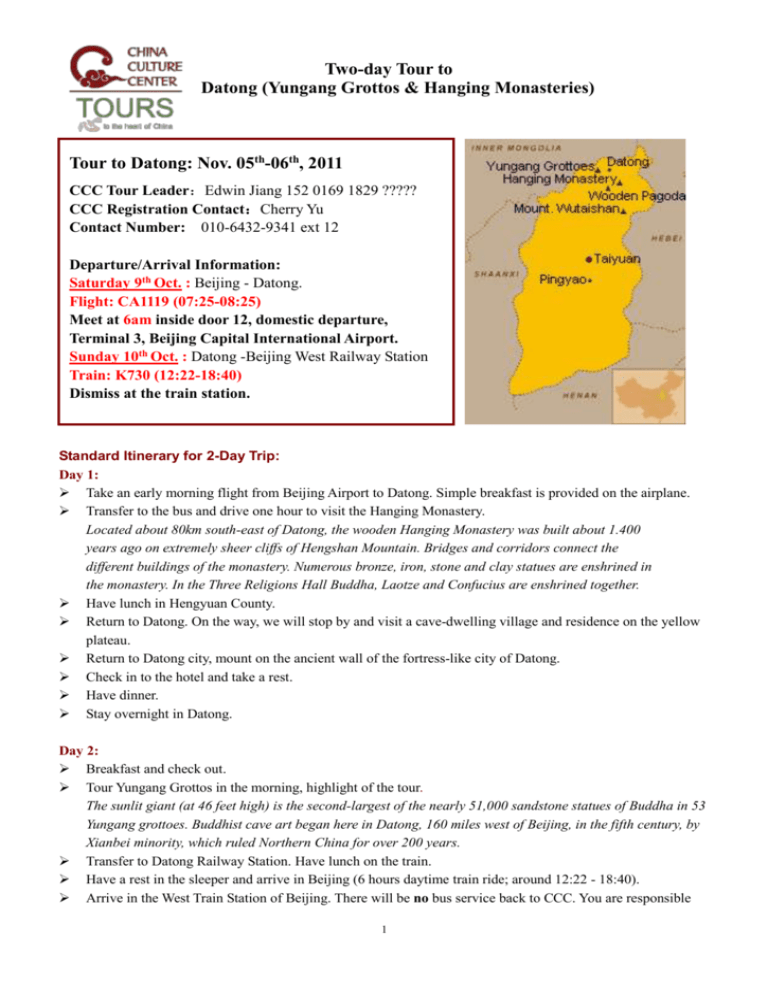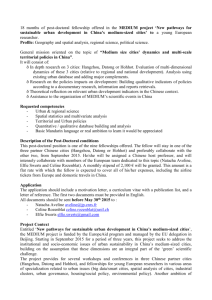Itinerary - China Culture Center
advertisement

Two-day Tour to Datong (Yungang Grottos & Hanging Monasteries) Tour to Datong: Nov. 05th-06th, 2011 CCC Tour Leader:Edwin Jiang 152 0169 1829 ????? CCC Registration Contact:Cherry Yu Contact Number: 010-6432-9341 ext 12 Departure/Arrival Information: Saturday 9th Oct. : Beijing - Datong. Flight: CA1119 (07:25-08:25) Meet at 6am inside door 12, domestic departure, Terminal 3, Beijing Capital International Airport. Sunday 10th Oct. : Datong -Beijing West Railway Station Train: K730 (12:22-18:40) Dismiss at the train station. Standard Itinerary for 2-Day Trip: Day 1: Take an early morning flight from Beijing Airport to Datong. Simple breakfast is provided on the airplane. Transfer to the bus and drive one hour to visit the Hanging Monastery. Located about 80km south-east of Datong, the wooden Hanging Monastery was built about 1.400 years ago on extremely sheer cliffs of Hengshan Mountain. Bridges and corridors connect the different buildings of the monastery. Numerous bronze, iron, stone and clay statues are enshrined in the monastery. In the Three Religions Hall Buddha, Laotze and Confucius are enshrined together. Have lunch in Hengyuan County. Return to Datong. On the way, we will stop by and visit a cave-dwelling village and residence on the yellow plateau. Return to Datong city, mount on the ancient wall of the fortress-like city of Datong. Check in to the hotel and take a rest. Have dinner. Stay overnight in Datong. Day 2: Breakfast and check out. Tour Yungang Grottos in the morning, highlight of the tour. The sunlit giant (at 46 feet high) is the second-largest of the nearly 51,000 sandstone statues of Buddha in 53 Yungang grottoes. Buddhist cave art began here in Datong, 160 miles west of Beijing, in the fifth century, by Xianbei minority, which ruled Northern China for over 200 years. Transfer to Datong Railway Station. Have lunch on the train. Have a rest in the sleeper and arrive in Beijing (6 hours daytime train ride; around 12:22 - 18:40). Arrive in the West Train Station of Beijing. There will be no bus service back to CCC. You are responsible 1 Two-day Tour to Datong (Yungang Grottos & Hanging Monasteries) for getting home from the train station. Useful information: Train Info: Please note that on the train back from Datong there is not much difference in quality between a hard sleeper and a soft sleeper, the latter having only the luxury of a door. Also for those who are particular about cleanliness it is recommended they bring something to lay on top of the bed. How to read your train ticket: example 05车10号上铺 (upper上; middle中; lower下) (“upper middle and lower” only applicable for hard sleeper) carriage 5, compartment 10, upper bunk Weather: Datong is a bit colder than Beijing, 18℃ to -27 (These are average temperatures so please double check the Weather forecast! Try www.weather.com) Hotel Info: Datong Garden Hotel (4 star) 大同花园大酒店 (四星级) Address: No.59, Danan Jie, Datong Telephone: 0352- 5865 888 Introduction to Datong Shanxi Shanxi, meaning "West of the Mountains", lies in the west part of northern China, covering an area of 156,300 square kilometers, and has a continental monsoon climate. Its population is 30,452,100, which includes ethnic groups such as Han, Muslim, Mongolian, and Manchurian. Shanxi contains 11 cities and 118 counties with its provincial capital set in Taiyuan City. The province is one of China's major energy bases with its rich coal and iron deposits. Having 35 key historical relics under nationwide protection and 284 under provincial protection, the province of Shanxi is also known as Ancient Chinese Art Museum. National key scenic areas in this province include the Wutai Mountain, the Heng Mountain, and the Waterfalls at Hukou along the Yellow River. Its famous Chinese historical and cultural cities include Datong City, Pingyao City, Xinjiang City, Dai County, and Qi County. The Jin Ancestral Hall, the Huayan Temple, the Yongle Palace, the Xuankong (Hanging) Temple, ancient pagodas, and grottoes (especially the Yungang Grottoes) are also very famous. Datong It has a history of over 2000 years and is listed among the 24 foremost historical cities in China. The Northern Wei Dynasty made Datong its capital 2 Two-day Tour to Datong (Yungang Grottos & Hanging Monasteries) from 398 to 494 AD. Datong served as the political, economic and cultural center of northern China, and was then one of the largest cities in the world. It was also the alternate capital of Liao & Jin Dynasties, and known as the West Capital. In Ming & Qing Dynasties, it became a prefecture, one of the nine important strongholds along the Great Wall. Datong has world-class historical and cultural heritages: Yungang Grottoes, the Upper & Lower Huayan Temple, the Shanhua Temple and the Nine Dragon Screen. Location: northern part of Shanxi Province, the center of Datong Basin Neighboring Areas: Hebei, Henan, and Shaanxi Provinces and the Inner Mongolia Autonomous Region Physical Features: Datong is surrounded by mountains, and its central and southern parts are occupied by plains. Its topography slopes downward from northwest to southeast. The Yu River runs from south to north. Population: 926,000 Area: 2,071 sq km Nationalities: Han History: Served as capital during the Northern Wei dynasty. Was renamed Heng'an County during the Northern Qin dynasty. Was renamed Yunzhong in Sui dynasty. Was recognized as Datong during the Ming and Qing dynasties. After the founding of the P.R.C., it became part of the Shanxi province Climate: dry and windy, big temperature difference between day and night, annual rainfall 400-500mm, and frost-free 125 day of the year. Average Temperature: 6.4 C Rainfall: an annual precipitation of 400-500mm Rivers: Yu River, Shili River, Kouquan River Products: grain, corn, potato, wheat, oat, vegetable Local Highlights: copper pot, ceramic Yungang Grottoes Driving along roads lined with grimy trucks loaded with coal, you eventually arrive at the Yungang Grottoes (Yungang shiku) with some doubt. The affects of man's occupation of the Datong area is noticable in so many ways, from the fumes of black sooty smoke that plumes from factory chimneys, to the crowds that litter the streets and trample the paths. The Yungang area has, not just recently, seen the worst and the best of this human inventiveness. The grottoes lie 16km west of Datong, dug out of a sandstone cliff that is a part of the large Wuzhoushan Mountain range. The long stretch of caves was a masterpiece comparable to the ancient Egyptian pyramids, taking 40,000 workmen many decades (453-493 AD) to finish the majority of construction. In its golden days Yungang was about 15km long, and it still remains one of the better grotto complexes along with Dunhuang's Mogao Grottoes, Luoyang's Longmen Caves and Tianshui's Maijishan Grottoes. 3 Two-day Tour to Datong (Yungang Grottos & Hanging Monasteries) However, man and nature made their mark. The ravages of time, mismanagement and anti-Buddhist movements all worked against the caves. In more recent years it was the Cultural Revolution (1967-77) that resulted in the removal of a small number of Buddha heads, and pollution, which covered statues with coal dust and grime, which have further reduced the beauty of the place. What remains of the sight is a one kilometer stretch containing 53 caves. But what a stretch! There are a total of 50,000 statues contained inside, including a variety of Buddhas, Boddhisattvas, Apsaras (Buddhist angels), birds and other animals. Some are impressively detailed, others are austerely beautiful, some are in darkened nooks that can only be scantily revealed, others are fully open to the rays of light that penetrate the murky skies. You can spend hours wandering about the caves, although you should make sure to see the central caves (No.'s 5-13) and should not miss the largest outdoor seated Buddha of Sakyamuni, who squats at a height of 14 meters above ground in cave 20. Most of the caves have fairly good English descriptions. Hanging Monastery in Henshan Mountain Perched precariously on a near-vertical cliff face of the Golden Dragon Gorge (Jinlong guan) is the Hanging Monastery or the Monastery in Mid-Air (Xuankong si). This is an early architectural feat that is stunning, particularly when you know that the original temple was built in the Northern Wei Dynasty over 1,400 years ago (although later renovated in the Tang, Jin, Ming and Qing Dynasties). The monastery has many peculiarities that make it uniquely exciting, although in season there is so little room within the narrow complex that it can be hard to appreciate. The temple was gradually built on pillars that were thrust into natural or man-made holes in the rockface behind. Despite being built upon one of China's four most sacred Taoist mountains, Hengshan, the monastery has also had many other religious influences. This is no better highlighted than in the Three Religion's Hall (Sansheng dian) where Buddha, Confucius and Laotzu (Taoism's founder) sit side by side. Those driving to the sight will arrive in the car park on the opposite side of the Golden Dragon River (Jinlong he), a shallow blue stretch of water that meanders between mountains. The monastery, seeming to cling half way up the cliff, is approached over a bridge and up a stone staircase that has been chiseled from the rockface. The total of 6 main halls and various side rooms above are linked by winding corridors, bridges, and boardwalks, with some amazing glimpsed views of the world below. The temple contains a good, although small, collection of bronze & iron work, various collections of wood and stone carvings and some clay statues. 4 Two-day Tour to Datong (Yungang Grottos & Hanging Monasteries) 5








